1997 CHEVROLET CAVALIER engine overheat
[x] Cancel search: engine overheatPage 267 of 388
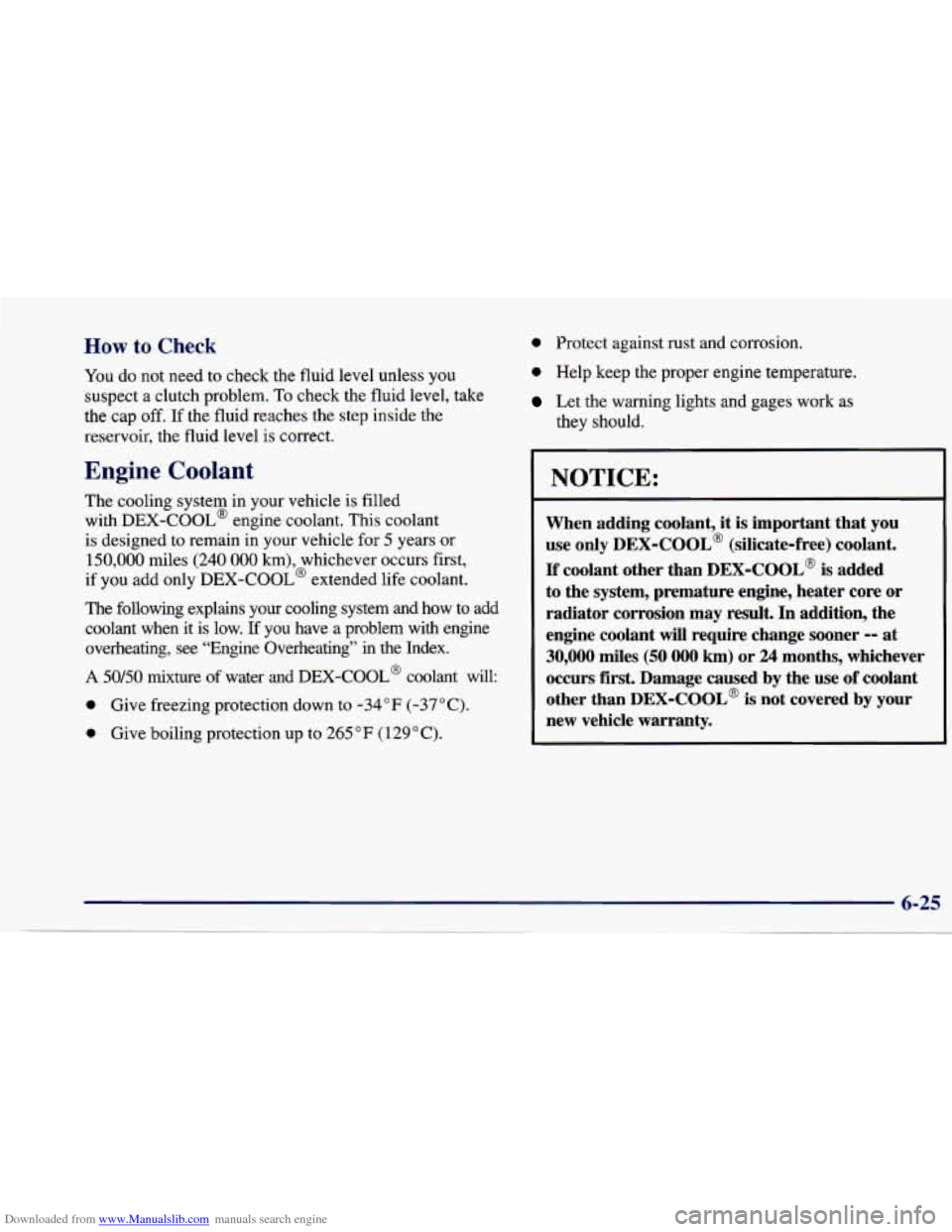
Downloaded from www.Manualslib.com manuals search engine How to Check
You do not need to check the fluid level unless you
suspect
a clutch problem. To check the fluid level, take
the cap
off. If the fluid reaches the step inside the
reservoir, the fluid level
is correct.
Engine Coolant
The cooling system in your vehicle is filled
with DEX-COOL@ engine coolant. This coolant
is designed to remain in your vehicle for
5 years or
150,000 miles (240 000 km), whichever occurs first,
if you add only DEX-COOL@ extended life coolant.
The following explains your cooling system and how to add
coolant when it is low.
If you have a problem with engine
overheating, see “Engine Overheating”
in the Index.
A 50/50 mixture of water and DEX-COOL@ coolant will:
0 Give freezing protection down to -34°F (-37°C).
0 Give boiling protection up to 265 “F (129°C).
0 Protect against rust and corrosion.
0 Help keep the proper engine temperature.
Let the warning lights and gages work as
they should.
NOTICE:
I
When adding coolant, it is important that you
use only
DEX-COOL@ (silicate-free) coolant.
If coolant other than
DEX-COOL’ is added
to the system, premature engine, heater core or
radiator corrosion may result. In addition, the
engine coolant will require change sooner
-- at
30,000 miles (50 000 km) or 24 months, whichever
occurs
first. Damage caused by the use of coolant
other than
DEX-COOL@ is not covered by your
new vehicle warranty.
Page 268 of 388
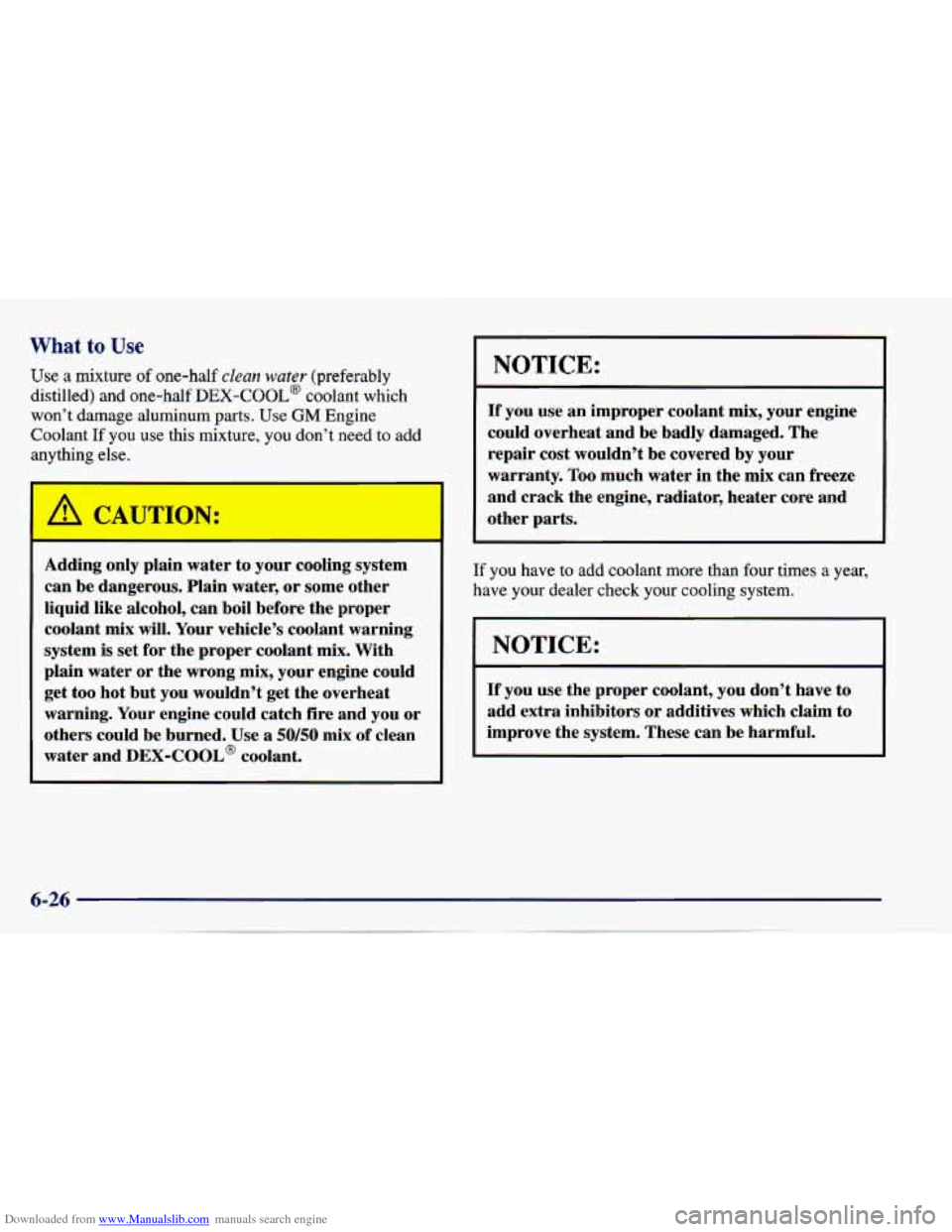
Downloaded from www.Manualslib.com manuals search engine What to Use
Use a mixture of one-half clean water (preferably
distilled) and one-half
DEX-COOL@ coolant which
won’t damage aluminum
parts. Use GM Engine
Coolant If you use this mixture, you don’t need to add
anything else.
Adding only plain water
to your cooling system
can be dangerous. Plain water, or some other
liquid like alcohol, can boil before the proper
coolant mix will. Your vehicle’s coolant warning
system is set for the proper coolant mix. With
plain water or the wrong mix, your engine could
get too hot but you wouldn’t get the overheat
warning. Your engine could catch fire and you
or
others could be burned. Use a 50/50 mix of clean
water and
DEX-COOL@ coolant.
NOTICE:
If you use an improper coolant mix, your engine
could overheat and be badly damaged. The
repair cost wouldn’t be
covered by your
warranty. Too much water in the mix can freeze
and crack the engine, radiator, heater core and
other parts.
[f you have to add coolant more than four times a year,
lave your dealer check your cooling system.
NOTICE:
If you use the proper coolant, you don’t have to
add extra inhibitors or additives which claim to
improve the system. These can be harmful.
Page 270 of 388
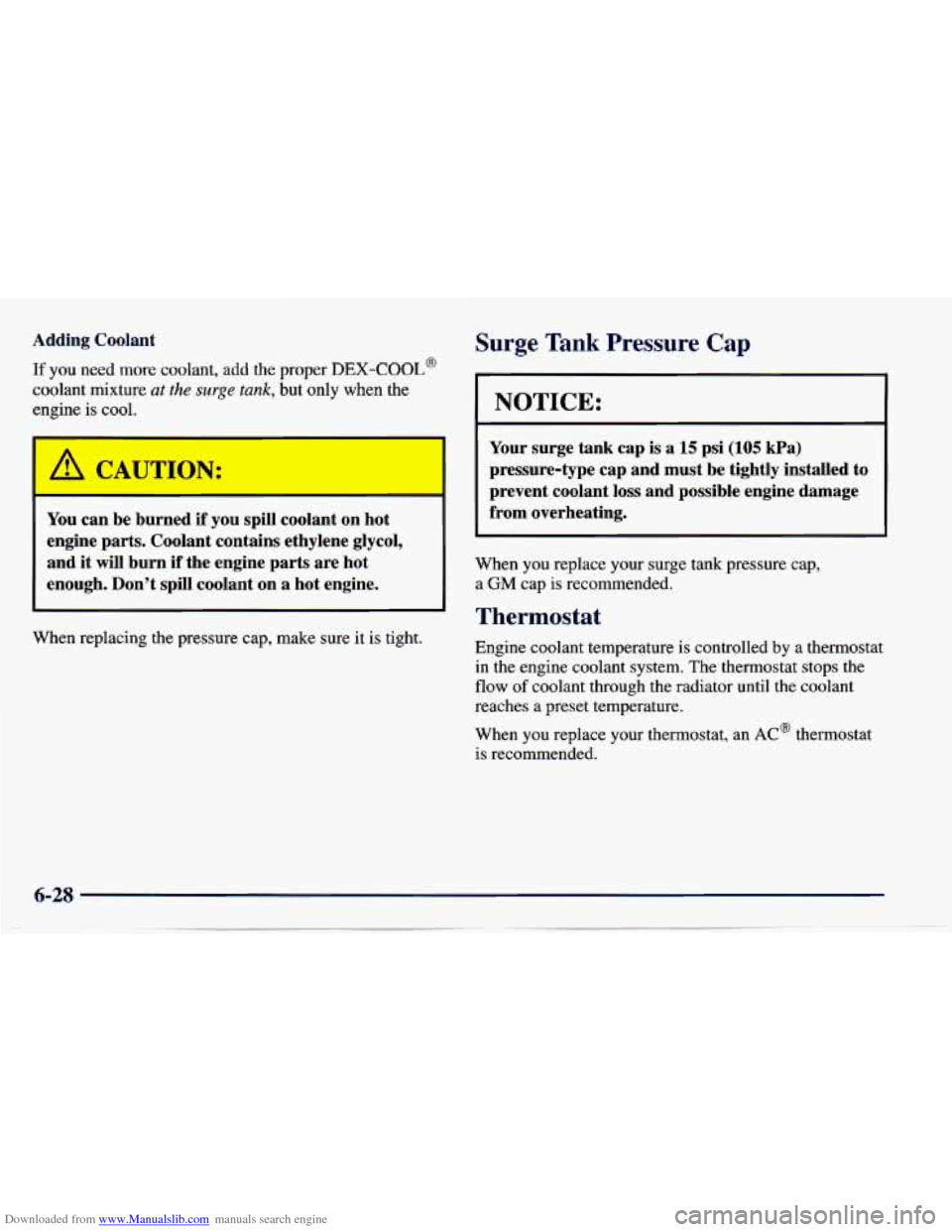
Downloaded from www.Manualslib.com manuals search engine Adding Coolant
If you need more coolant, add the proper DEX-COOL@
coolant mixture at the surge tank, but only when the
engine
is cool.
~~
A CAUTION:
You can be burned if you spill coolant on hot
engine parts. Coolant contains ethylene glycol,
and it will burn
if the engine parts are hot
enough. Don’t spill coolant
on a hot engine.
When replacing the pressure cap, make sure it is tight.
Surge Tank Pressure Cap
NOTICE:
Your surge tank cap is a 15 psi (105 kPa)
pressure-type cap and must be tightly installed
to
prevent coolant loss and possible engine damage
from overheating.
When you replace your surge tank pressure cap,
a
GM cap is recommended.
Thermostat
Engine coolant temperature is controlled by a thermostat
in the engine coolant system. The thermostat stops the
flow of coolant through the radiator until the coolant
reaches a preset temperature.
When you replace your thermostat, an
AC@ thermostat
is recommended.
Page 282 of 388
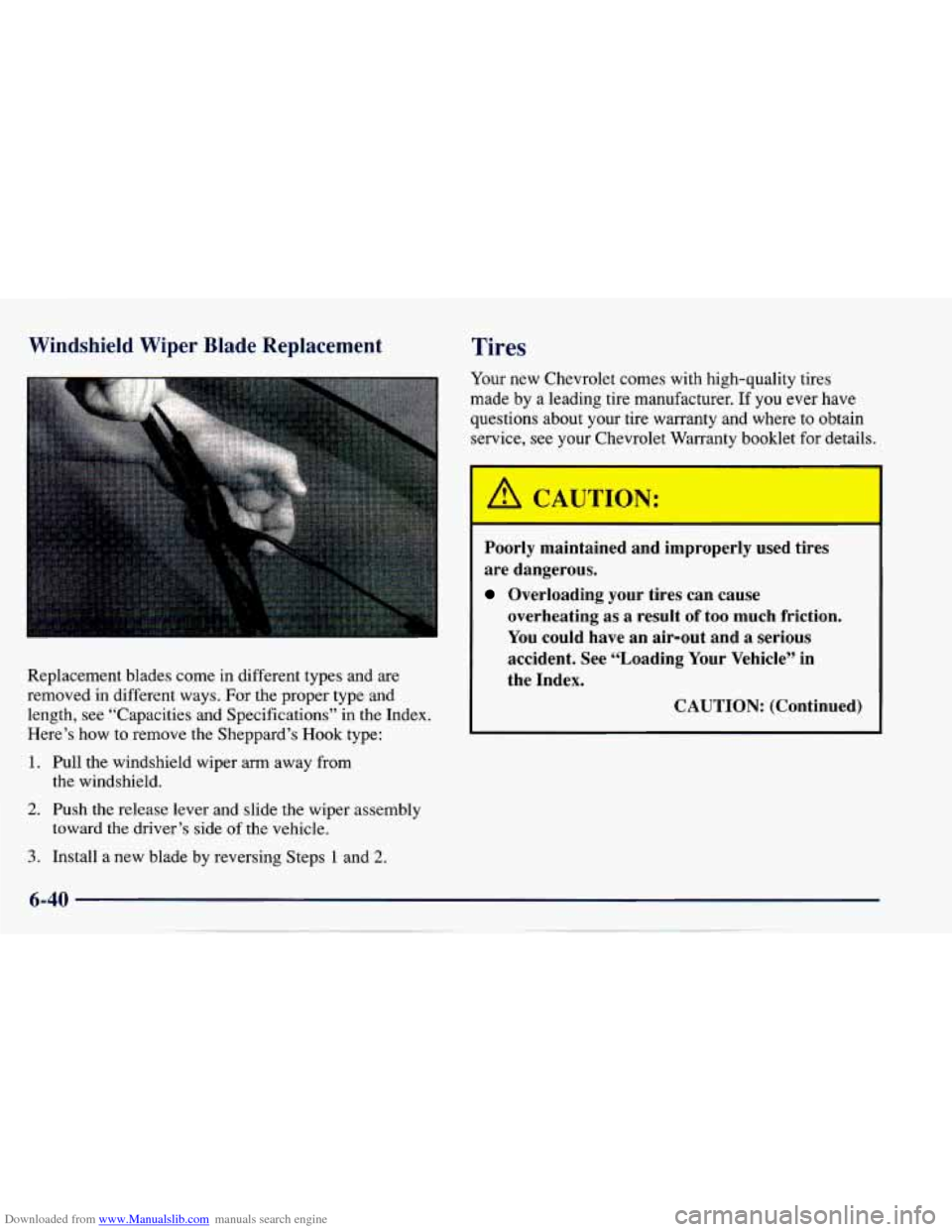
Downloaded from www.Manualslib.com manuals search engine Windshield Wiper Blade Replacement
Replacement blades come in different types and are
removed in different ways. For the proper type and
length, see “Capacities and Specifications” in the Index.
Here’s how to remove the Sheppard’s Hook type:
1. Pull the windshield wiper arm away from
the windshield.
2. Push the release lever and slide the wiper assembly
3. Install a new blade by reversing Steps 1 and 2.
toward the driver’s side of the vehicle.
Tires
Your new Chevrolet comes with high-quality tires
made by
a leading tire manufacturer. If you ever have
questions about your tire warranty and where to obtain
service, see your Chevrolet Warranty booklet for details.
I A CAUTION:
Poorly maintained and improperly used tires
are dangerous.
Overloading your tires can cause
overheating as
a result of too much friction.
You could have an air-out and a serious
accident. See “Loading
Your Vehicle” in
the Index.
CAUTION: (Continued)
Page 301 of 388
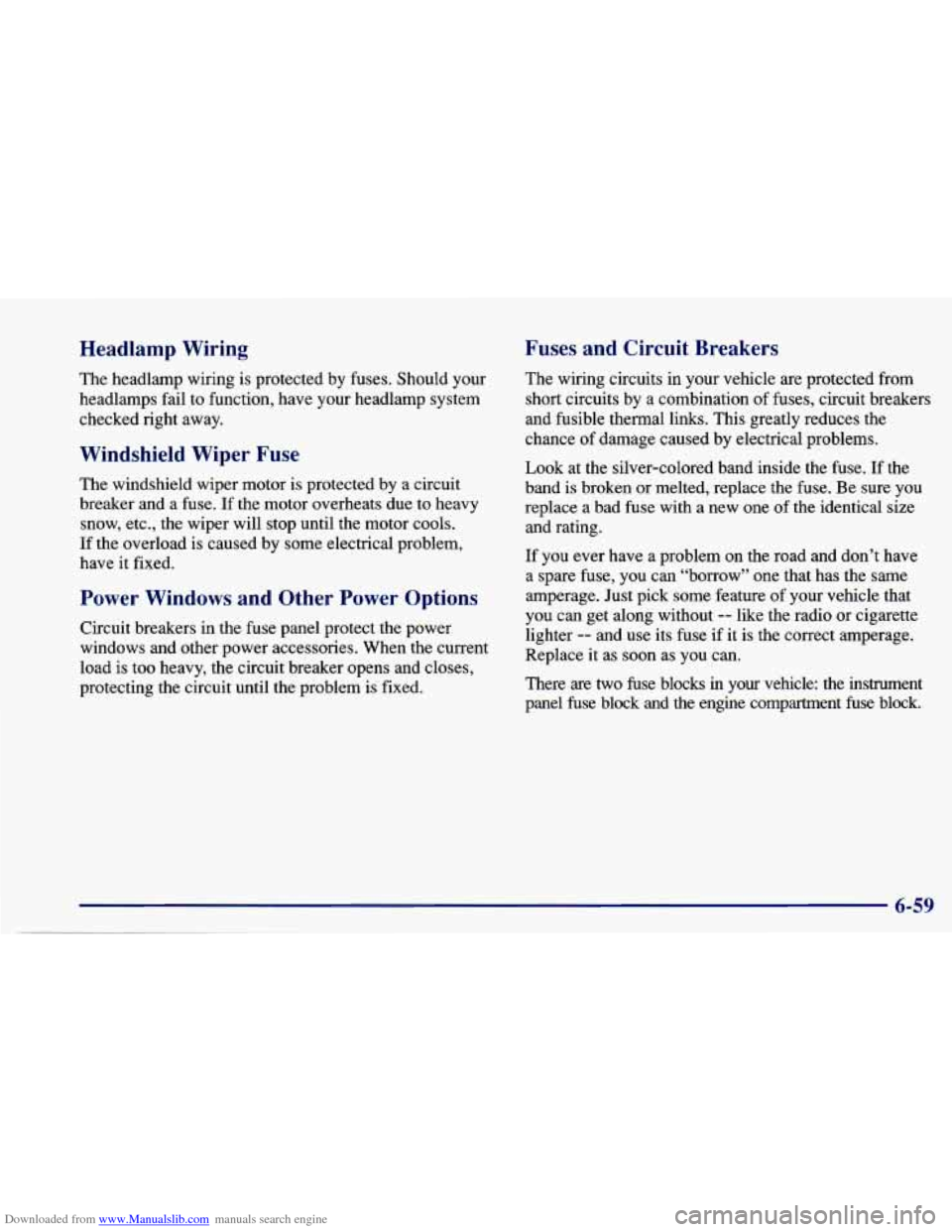
Downloaded from www.Manualslib.com manuals search engine Headlamp Wiring Fuses and Circuit Breakers
The
headlamp wiring is protected by fuses. Should your
headlamps fail to function, have your headlamp system
checked right away.
Windshield Wiper Fuse
The windshield wiper motor is protected by a circuit
breaker and a fuse. If the motor overheats due to heavy
snow, etc., the wiper will stop until the motor cools.
If the overload is caused by some electrical problem,
have it fixed.
Power Windows and Other Power Options
Circuit breakers in the fuse panel protect the power
windows and other power accessories. When the current
load
is too heavy, the circuit breaker opens and closes,
protecting the circuit until the problem is fixed. The
wiring circuits in your vehicle
are protected from
short circuits by a combination of fuses, circuit breakers
and fusible thermal links. This greatly reduces the
chance of damage caused by electrical problems.
Look at the silver-colored band inside the fuse. If the
band is broken or melted, replace the fuse. Be sure you
replace a bad fuse with a new one of the identical size
and rating.
If you ever have
a problem on the road and don’t have
a spare fuse, you can “borrow” one that has the same
amperage. Just pick some feature of your vehicle that
you can get along without
-- like the radio or cigarette
lighter
-- and use its fuse if it is the correct amperage.
Replace it as
soon as you can.
There are
two fuse blocks in your vehicle: the instrument
panel fuse block and the engine compartment
fuse block.
6-59
Page 378 of 388
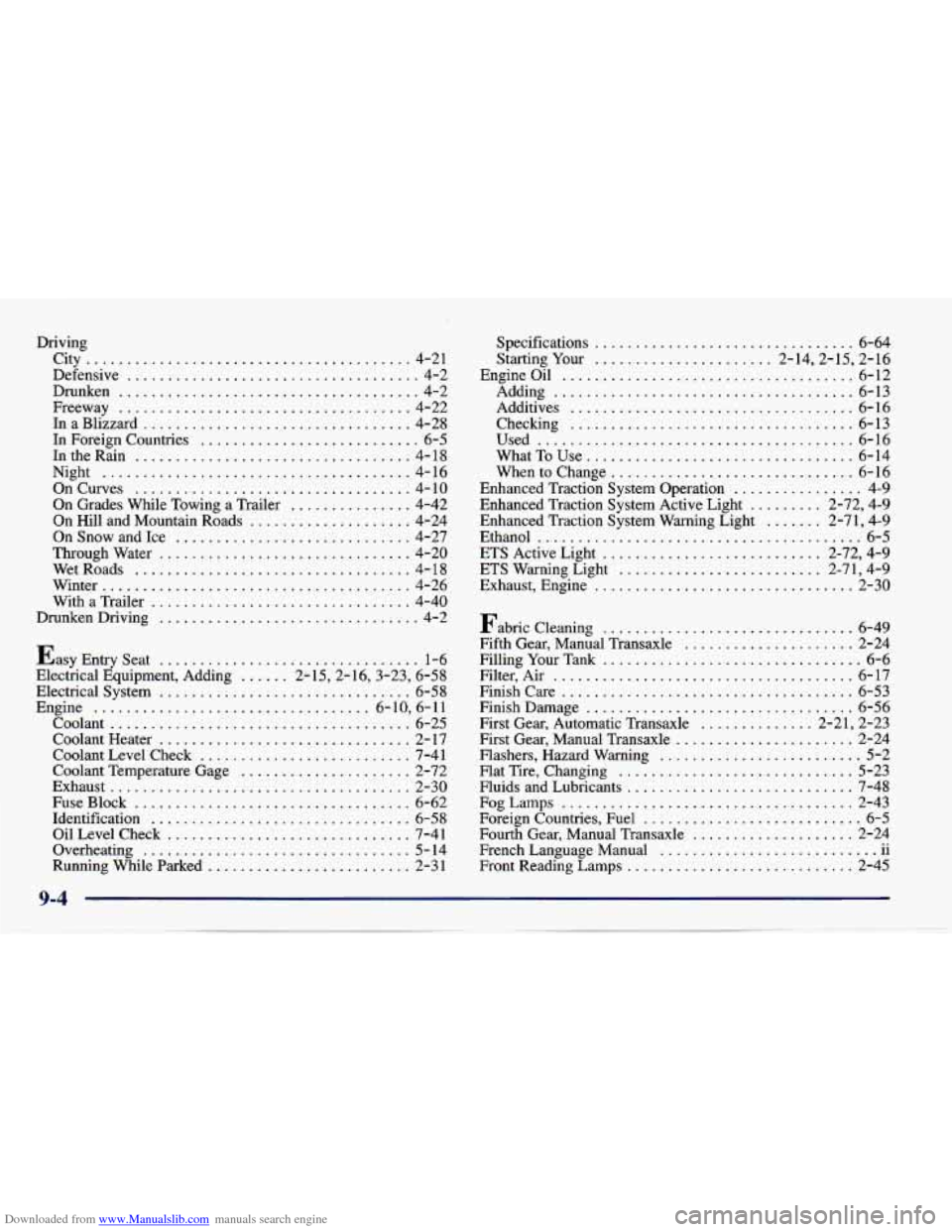
Downloaded from www.Manualslib.com manuals search engine Driving City
........................................ 4-21
Defensive
.................................... 4-2
Drunken
..................................... 4-2
Freeway
.................................... 4-22
InaBlizzard
................................. 4-28
In Foreign Countries
........................... 6-5
In the Rain
.................................. 4- 18
Night
...................................... 4-16
OnCurves
.................................. 4-10
On Grades While Towing a Trailer
............... 4-42
On Hill and Mountain Roads
.................... 4-24
OnSnowandIce
............................. 4-27
Throughwater
............................... 4-20
WetRoads
.................................. 4-18
Winter
...................................... 4-26
With a Trailer
................................ 4-40
DrunkenDriving
................................ 4-2
Easy Entry Seat ................................ 1-6
Electrical Equipment. Adding ...... 2-15.2-16.3-23. 6-58
Electrical System
............................... 6-58
Engine
.................................. 6-10. 6-11
Coolant
..................................... 6-25
Coolant Heater
............................... 2- 17
Coolant Level Check
.......................... 7-41
Coolant Temperature Gage
..................... 2-72
Exhaust
..................................... 2-30
Fuse Block
.................................. 6-62
Identification
................................ 6-58
OilLevelCheck
.............................. 7-41
Overheating
................................. 5-14
Running While Parked
......................... 2-31 Specifications
................................ 6-64
Starting Your
...................... 2.14.2.15. 2.16
Engineoil
.................................... 6-12
Adding
..................................... 6-13
Additives
................................... 6-16
Checking
................................... 6-13
Used
....................................... 6-16
What
To Use ................................. 6-14
When to Change
.............................. 6-16
Enhanced Traction System Operation
................ 4-9
Enhanced Traction System Active Light
......... 2.72. 4.9
Enhanced Traction System Warning Light
....... 2.71. 4.9
Ethanol
........................................ 6-5
ETS Active Light ........................... 2.72. 4.9
ETS Warning Light
......................... 2.71. 4.9
Exhaust. Engine
................................ 2-30
Fabric Cleaning
............................... 6-49
Fifth Gear. Manual Transaxle
..................... 2-24
Filling Your Tank ................................ 6-6
Filter. Air
..................................... 6-17
Finishcare
.................................... 6-53
Finish Damage
................................. 6-56
First Gear. Automatic Transaxle
.............. 2.21. 2.23
First Gear. Manual Transaxle
...................... 2-24
Flashers. Hazard Warning
......................... 5-2
Flat Tire. Changing
............................. 5-23
Fluids and Lubricants
............................ 7-48
FOgLmps
.................................... 2-43
Foreign Countries. Fuel
........................... 6-5
Fourth Gear. Manual Transaxle .................... 2-24
French Language Manual
11 1. ...........................
Front Reading Lamps ............................ 2-45
Page 381 of 388
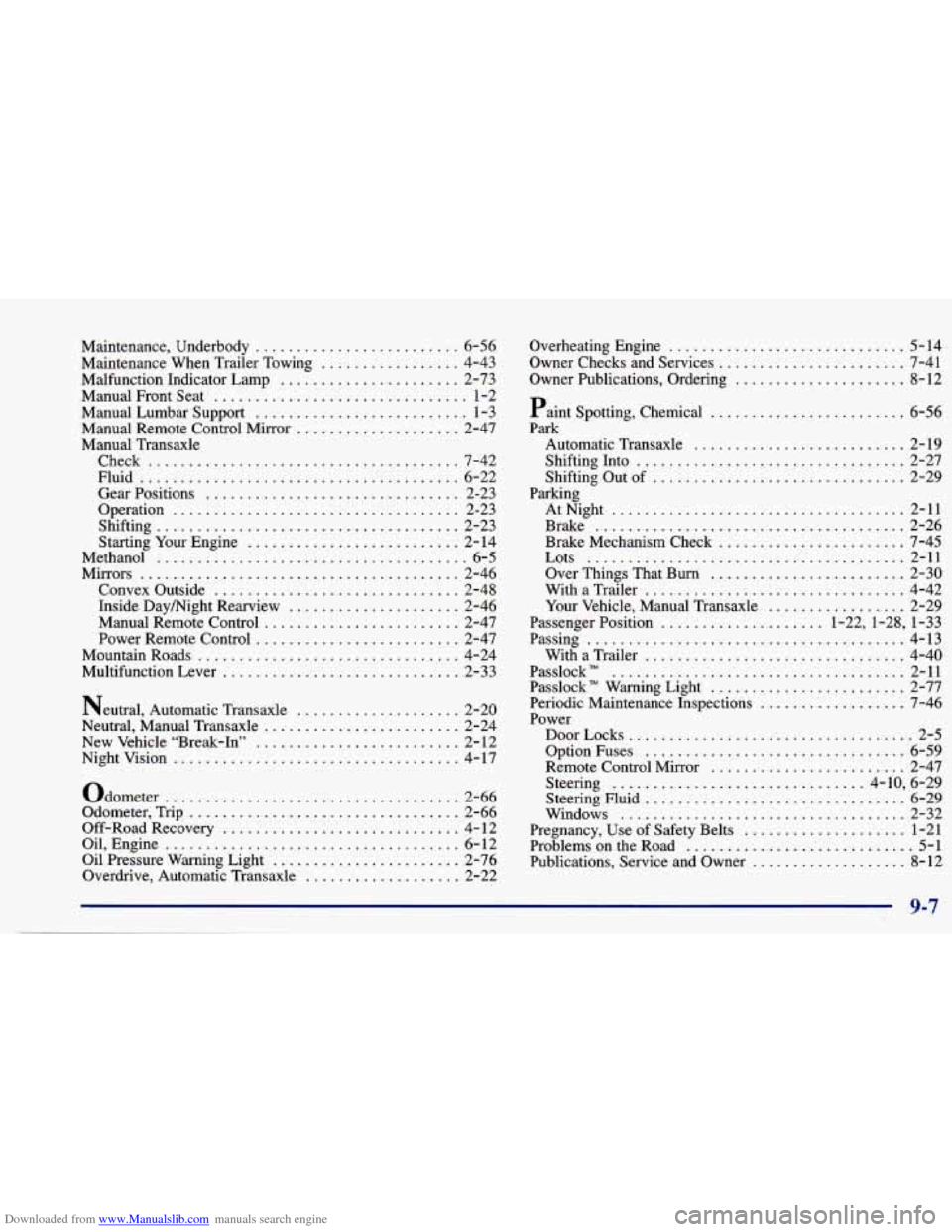
Downloaded from www.Manualslib.com manuals search engine Maintenance. Underbody ......................... 6-56
Maintenance When Trailer Towing
................. 4-43
Malfunction Indicator Lamp
...................... 2-73
Manual Front Seat
............................... 1-2
Manual Lumbar Support
.......................... 1-3
Manual Remote Control Mirror .................... 2-47
Manual Transaxle Check
...................................... 7-42
Fluid
....................................... 6-22
Gear Positions
............................... 2-23
Operation
................................... 2-23
Shifting
..................................... 2-23
Starting Your Engine
.......................... 2-14
Methanol
...................................... 6-5
Mirrors
....................................... 2-46
Convex Outside
.............................. 2-48
Inside Daymight Rearview
..................... 2-46
Manual Remote Control
........................ 2-47
Power Remote Control
......................... 2-47
MountainRoads
................................ 4-24
Multifunction Lever
............................. 2-33
Neutral. Automatic Transaxle
.................... 2-20
Neutral. Manual Transaxle
........................ 2-24
New Vehicle “Break-In”
......................... 2-12
Nightvision
................................... 4-17
Odometer
.................................... 2-66
Odometer. Trip
................................. 2-66
Off-Road Recovery
............................. 4- 12
Oil. Engine
.................................... 6-12
Oil Pressure Warning Light
....................... 2-76
Overdrive. Automatic Transaxle
................... 2-22 Overheating Engine
............................. 5-14
Owner Checks and Services
....................... 7-41
Owner Publications. Ordering
..................... 8-12
Paint Spotting. Chemical
........................ 6-56
Park
Automatic -:ansaxle
.......................... 2-19
Shifting Into
................................. 2-27
Shifting Out of
............................... 2-29
Parking AtNight
.................................... 2-11
Brake
...................................... 2-26
Brake Mechanism Check
....................... 7-45
Lots
....................................... 2-11
Over Things That Burn
........................ 2-30
With a Trailer
................................ 4-42
Your Vehicle. Manual Transaxle
................. 2-29
Passenger Position
.................... 1-22. 1-28. 1-33
Passing
....................................... 4-13
With a Trailer ................................ 4-40
Passlock
” .................................... 2-11
Periodic Maintenance Inspections
.................. 7-46
Power
DoorLocks
................................... 2-5
Option Fuses
................................ 6-59
Remote Control Mirror
........................ 2-47
Steering
............................... 4.10. 6.29
Windows
................................... 2-32
Pregnancy. Use of Safety Belts
.................... 1-21
Problems on the Road
............................ 5-1
Publications. Service and Owner
................... 8-12
Passlock”
Warning Light
........................ 2-77
Steering Fluid
................................ 6-29
9-7